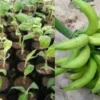- このトピックは空です。
- 投稿者投稿
- 3月 26, 2025 11:08 am #607283

Siam weed (Chromolaena odorata), a fast-growing perennial shrub native to the Americas, has become a notorious invasive species across tropical and subtropical regions worldwide. Its aggressive spread poses a significant threat to biodiversity and agricultural productivity.
A key factor contributing to its invasiveness is its ability to inhibit the growth and establishment of other plants through the release of allelochemicals, a phenomenon known as allelopathy. Understanding the allelopathic effects of Siam weed on native plant communities and agricultural crops is crucial for developing effective management strategies and mitigating its ecological and economic impacts.
1. Identification Of Allelochemicals In Siam Weed
The allelopathic potential of Siam weed is attributed to the presence of various secondary metabolites in its tissues. Research has identified several classes of compounds that contribute to its inhibitory effects. These include flavonoids, phenolic acids, terpenoids, and alkaloids.
The specific compounds and their concentrations can vary depending on the plant part (leaves, stems, roots, flowers), the growth stage of Siam weed, and environmental conditions.
Techniques such as gas chromatography-mass spectrometry (GC-MS) and high-performance liquid chromatography (HPLC) are instrumental in identifying and quantifying these allelochemicals. Understanding the chemical arsenal of Siam weed is the first step in unraveling the mechanisms behind its allelopathic dominance.
2. Mechanisms Of Allelopathic Inhibition
Siam weed releases these allelochemicals into the environment through various pathways, including the decomposition of leaf litter, root exudation, and volatilization from leaves. Once released, these compounds can interfere with various physiological processes in susceptible plants.
Common mechanisms of allelopathic inhibition include the disruption of seed germination and seedling growth, inhibition of root and shoot elongation, interference with nutrient uptake, reduction in photosynthetic activity, and impairment of enzyme function. The severity of the effect can depend on the concentration of the allelochemicals, the sensitivity of the target species, and soil characteristics.
3. Impact On Native Plant Communities
The allelopathic effects of Siam weed can significantly alter the structure and composition of native plant communities. By suppressing the growth of indigenous species, Siam weed can reduce biodiversity, leading to the formation of monocultures. This loss of native plant diversity can have cascading effects on the ecosystem, impacting herbivores that rely on specific plants for food, pollinators, and soil health.
Studies have documented the displacement of native grasses, forbs, and even tree seedlings in areas invaded by Siam weed, highlighting its ability to outcompete and suppress native flora. This disruption of native ecosystems can have long-term consequences for ecosystem stability and resilience.
4. Impact On Agricultural Crops
The economic impact of Siam weed is particularly evident in agricultural settings. Its allelopathic effects can significantly reduce the yield of various crops. Studies have shown that Siam weed can inhibit the germination and growth of important staple crops such as rice, maize, soybeans, and vegetables. The presence of Siam weed residues in the soil or direct competition can lead to stunted growth, reduced biomass, and lower grain or fruit production.
This not only affects the income of farmers but also threatens food security in regions heavily infested by this weed. Understanding the specific crops that are most susceptible to Siam weed allelopathy is crucial for developing targeted weed management strategies.
5. Factors Influencing Allelopathic Activity
The allelopathic activity of Siam weed is not constant and can be influenced by several factors. Environmental conditions such as temperature, rainfall, soil pH, and nutrient availability can affect the production and release of allelochemicals.
The growth stage of Siam weed also plays a role, with some studies suggesting that allelopathic potential may be higher during certain phases of development. Furthermore, interactions with soil microorganisms can modify the allelochemicals, either enhancing or reducing their inhibitory effects.
Understanding these influencing factors is important for predicting the impact of Siam weed in different environments and optimizing management strategies.
The allelopathic properties of Siam weed are a significant factor contributing to its invasive success and the negative impacts it has on both natural ecosystems and agricultural productivity.
By releasing a cocktail of inhibitory chemicals, Siam weed can suppress the growth of native plants, leading to a reduction in biodiversity, and diminish the yields of important crops, threatening food security.
Continued research into the specific allelochemicals involved, their mechanisms of action, and the factors that influence their activity is essential for developing effective and sustainable strategies to manage this problematic weed and mitigate its detrimental effects.
Read Also: How to Manage Siam Weed: Effective Control Methods for Homeowners and Gardeners
- 投稿者投稿
- このトピックに返信するにはログインが必要です。






